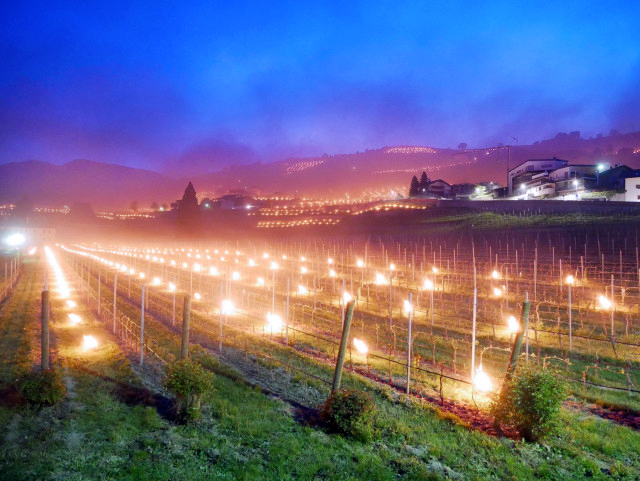Fighting Mother Nature
The vineyards of northern Italy have been burning bright this week as winemakers light thousands of torches across the slopes. It was an enterprising solution to a perennial problem – the weather. As frost and snow returned unseasonably late to areas of the north, winemakers sought to protect their vines from freezing temperatures, which can wipe out tender new growth where grapes are just starting to emerge. With temperatures in some area forecasted to drop as low as 20°F, winemakers prepared by positioning anti-frost torches every few yards throughout their vineyards, setting them ablaze as the mercury started to fall. 300 torches for each hectare (about 2.5 acres) can raise the temperature by 3°F. In the province of Trento, which saw its lowest seasonal temperatures since 1987, farmers took anti-frost precautions in vineyards and apple orchards. Since most are on lower slopes, they are thought to have escaped the worst of the freeze. Winemakers in Tuscany also adopted this protection.
No Cure in Sight
A recent announcement by the European Food Safety Agency indicated that there is still no known cure for the olive-tree-killing Xylella bacteria. They also warned that it poses a risk to plants and crops throughout Europe. The deadly bacterial pathogen was first detected in 2013, when an outbreak hit olive trees in the region of Puglia, causing scores of ancient trees to die off. Experts have thus far been unable to determine where the disease has come from. More than a million trees are estimated to have been infected in the region, where abundant olive groves have thrived for centuries. Xylella does not harm humans but can kill over 200 types of plants, including fruit trees and grape vines. Further frustrating experts is that it is not known how the disease spreads. EU emergency control measures are in place in all of the outbreak areas. The xylella outbreak has also been blamed for a steep increase in olive oil prices during the last few years.
Top Pick for Summer Vacations
The world’s largest guide book publisher, Lonely Planet, has released its annual list of Europe’s top summer destinations and among the favorites was the Pugliese capital of Bari. The southern region of Puglia has long been a favorite summer destination for travelers in the know, but most head straight for the beaches overlooking its capital city, Bari. That is likely to change now that the city has been named as a travel guidebook favorite. It is popular with those seeking a slice of authentic Italy, with fewer crowds, lower prices and a slower pace of life than that found in many better-known Italian destinations. Beyond the city, the region of Bari encompasses a long stretch of scenic, rocky Adriatic coastline, including the famous seaside towns of Monopoli and Polignano a Mare. Inland, the area’s iconic rural landscape is filled with olive groves and dotted with white masserie (fortified farmhouses) and the conical trulli houses.
Worth the Wait
Even by Italian standards, three-quarters of a century is a long time for a building to be closed for renovation. That is how long it took for the historic Teatro Galli to reopen in the Emilia-Romagna’s coastal city of Rimini. The city’s municipal theater opened in 1857 with the opera “Aroldo” by Giuseppe Verdi, but the last performance there was in the spring of 1943. Afterwards, much of the building was destroyed by Allied bombing during WWII. The apse and the roof had collapsed and 90 percent of the auditorium and stage were destroyed. The only part that remained undamaged was the foyer. Luigi Poletti designed the theater to reflect the solemn magnificence of Roman temples and his was a monumental building of classical architecture, seating more than one thousand. With dozens of artisans, from woodworkers to plasterers and painters, working furiously during the last few years, the building has been gloriously reconstructed, based on the original design.
Nemo’s Garden
Sometime ago, Sergio Gamberini, a professional scuba diver and amateur gardener from Liguria began to wonder about growing vegetables underwater. He had a vision of a vegetable garden inside a transparent balloon filled with air. Gamberini, who is also a chemical engineer, was determined to prove that his idea could work, so he put on his diving gear and 22-feet below sea level, attached a plastic balloon filled with a little soil and basil seeds to the seabed. After a few days, tiny basil leaves were sprouting. The following year, Gamberini, began the first fully functional underwater farm. Today, his project, named “Nemo’s Garden,” counts six underwater greenhouses hosting an estimated 700 plants including basil, tomatoes, lettuce, mint and strawberries. The six-foot wide spheres are attached to the seafloor with removable screws, since in addition to the numerous challenges of making his idea work, Gamberini also had to contend with an obscure Italian law that prohibits any permanent changes to the Italian seafloor.
Italy as a Tax Haven
Wealthy non-Italians are moving to Italy after the country introduced a flat tax on even the largest of overseas fortunes. Introduced as part of a budget package that intended to attract wealthy investors to Italy, the tax ruling for resident non-domiciled taxpayers allows anyone who has not lived in Italy for nine out of the last ten years to apply to pay a flat €100,000 annual tax on all income generated outside Italy. The tax plan will be in place for at least another fifteen years. So far, about 400 of the super-rich have applied to move their tax domicile to Italy, taking advantage of the law. Real estate agents say the multi-million euro properties most sought after by Italy’s wealthy new residents tend to be concentrated in popular holiday destinations, such as Florence, Lake Como, Rome and the Amalfi Coast.





